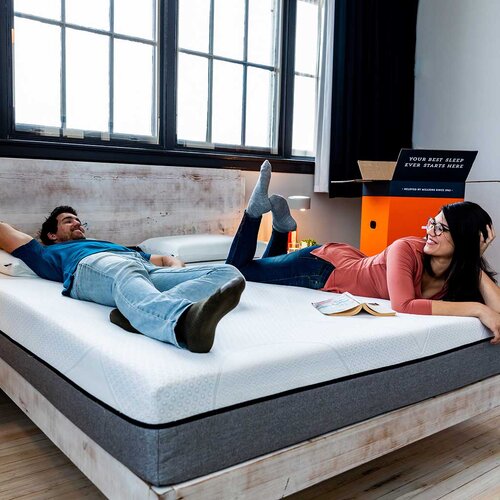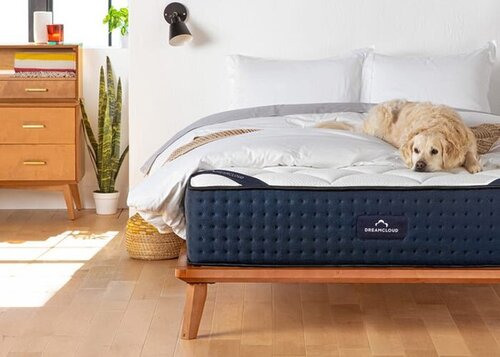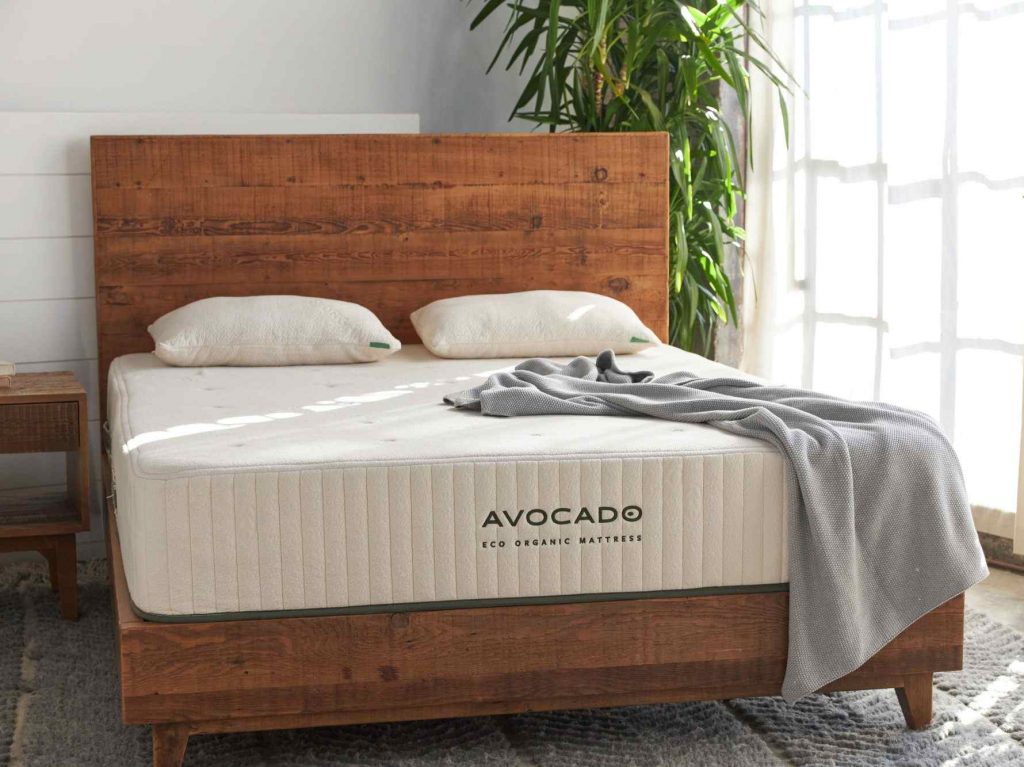The Worst Mattresses To Avoid: A 25 Year Mattress Industry Pro’s Advice
After spending 25 years as a veteran mattress manufacturer and reviewing over 250 mattresses sold online, the worst mattress you can buy generally have the following characteristics and should be avoided. In many cases, you can spend thousands of dollars on a brand name mattress and still end up being very disappointed. These might be the reason why:
- Poor Quality Materials: Poorly made mattresses often use low-quality materials that may wear out quickly or provide inadequate support. These materials can include lower-density polyurethane foam, inadequate coil systems, or inferior textiles or upholstery components. A mattress made with such materials may not offer the necessary comfort, support, or durability.
- Insufficient Support: A mattress that lacks proper support can lead to discomfort and pain. It may fail to maintain proper spinal alignment, causing issues such as back or neck pain. Insufficient support can stem from an inadequate coil system or a low-quality foam layer that doesn’t provide the necessary support for your body.
- Sagging and Deterioration: Some mattresses tend to develop sagging or indentations over time, especially if they use low-density foams or weak coil systems. Sagging can negatively affect the mattress’s support and comfort, leading to discomfort and a shortened lifespan. It’s important to choose a mattress with materials and construction techniques that resist sagging.
- Excessive Motion Transfer: If you share your bed with a partner, a mattress that allows excessive motion transfer can disrupt your sleep. Innerspring mattresses with interconnected coils or mattresses with insufficient motion isolation properties can cause disturbances when your partner moves during the night. Improper design and poor manufacturing skills can contribute to this problem.
- Uncomfortable Initial Feel And Body Contact Surface: Comfort is subjective, and a mattress that doesn’t suit your preferences can result in poor sleep quality. For example, some individuals may find mattresses with excessively firm or overly soft surfaces uncomfortable. It’s crucial to consider your preferred sleep position, body weight, and personal preferences when selecting a mattress.
- Lack of Temperature Regulation: If a mattress retains excessive heat, it can disrupt your sleep and lead to discomfort. Poorly ventilated mattresses or those made with materials that trap heat can cause you to sleep hot and sweat during the night.
- Inadequate Warranty or Return Policy: A mattress with a limited or no warranty, or a return policy that doesn’t allow sufficient time for testing and evaluation, can be a red flag. These limitations may indicate a lack of confidence in the mattress’s quality or the manufacturer’s unwillingness to stand behind their product.
- Excessive Firmness: While personal preferences for mattress firmness vary, mattresses that are excessively firm and lack adequate pressure relief can lead to discomfort and pressure point pain. My rule of thumb for buyers is always err on the side of softer rather than firmer.
- Heat Retention: Mattresses that trap body heat and do not provide sufficient airflow can cause discomfort and disrupt sleep. This can be particularly problematic for individuals who tend to sleep hot or experience night sweats. There are plenty of cooling mattresses with technology that help you sleep without getting hot.
- Poor Edge Support: Mattresses with weak or inadequate edge support can make it difficult to sit or sleep near the edge of the bed without feeling like you might roll off. This can limit the usable space on the mattress and reduce overall comfort.
It’s a common problem with many “bed in a box” mattress options, but after spending my career manufacturing these kinds of mattresses, I can help you avoid making a $2,000 mistake that wastes time and energy as well.
On this page, I’m going to teach you how to avoid buying the worst mattresses out there, and give you a few hand picked options that their owners love, mattresses that are worth the money, made with premium ingredients, and backed up with trial periods, warranties, and free return policies that are totally for real.
Opinions on mattresses can vary widely, and what may be considered the “worst” mattress for one person could be the most comfortable mattress on earth for the next.
It’s important to note that mattress preferences are subjective, and what may be a negative characteristic for one person might be tolerable or even preferred by someone else. When shopping for a mattress, it’s generally recommended to research different brands, read reviews from reliable sources, and consider your personal sleep needs and preferences to find a mattress that suits you best.
I’ve personally reviewed each and every mattress I recommend, including the company background, warranties, trial periods, and I’ve studied actual owner reviews, too, so you don’t have to second guess your purchase.
Just in case you want to cut to the chase and checkout 7 popular brands I rate as “best mattress” options, here are some I have reviewed, tested, slept on, and rated.
Here Are Mattress Brands That I Recommend If You Want To Cut To The Chase
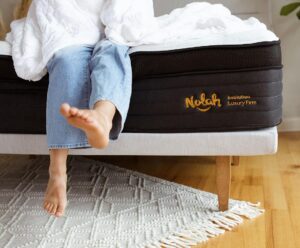 | Nolah Evolution Mattress-best for cooling, pain and side sleepers | Read My Review | $1,008 Off |
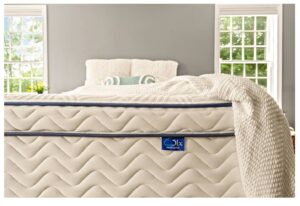 | DLX Premier Hybrid Mattress-overall best for comfort | Read My Review | $500 Off |
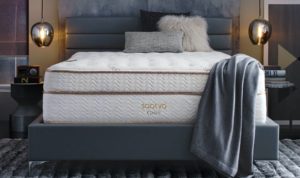 | Saatva Classic Mattress-best luxury innerspring | Read My Review | $600 Off |
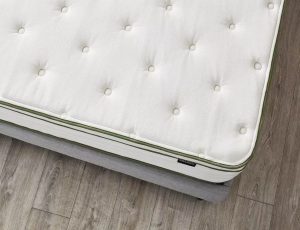 | Silk & Snow-best organic mattress | Read My Review | Pure Latex |
 | Sweetnight Prime Mem Foam Mattress-best pressure relief | Read My Review | $613 Off |
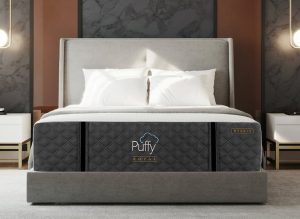 | Puffy Cloud Mattress-best medium firm option | Read My Review | $1,350 Off |
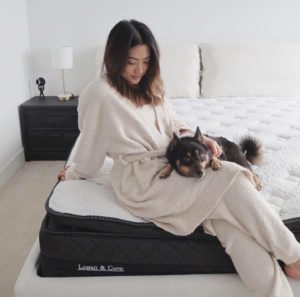 | Logan And Cove Hybrid Mattress-best back support | Read My Review | $600 Off |
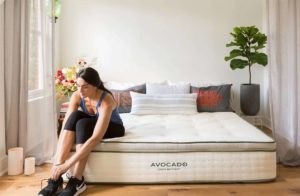 | Avocado Natural Latex Mattress-best for intimacy | Read My Review | 20% Off |
How To Avoid Making A $3,000 Mistake

With hundreds of online mattresses and WAY too many mattress review sites run by commission hungry digital marketing firms (mostly owned by the very mattress companies they are schilling for), landing a great mattress at your front door might seem impossible.
Actually, with the help of a 25 year mattress industry veteran, the choices become a little clearer when you weed out the worst mattress options not backed up with owner reviews, excellent components, and solid warranties and trial periods.
Fact is, about 50% of the population in America hates their mattress…I mean if it were a car, they’d drive it off a cliff. It’s difficult enough to find a new one either online or in a retail store, and when you pull the trigger on a $1,000 mattress, there’s a good chance you’re going to hate it in a few months or so anyway. Why is this? Not to worry, I’m going to explain why.
Most importantly, I’m going to help steer you away from the traps that mattress predators use to sell you a really awful mattress, and give you some bullet points and tips on where to buy a really great mattress, and for a fair price, with a free trial period- and maybe some freebies thrown it. Let’s get started.
How Predatory Online Mattress Companies Package Their Product For Curb Appeal- But Not Much Else.
First of all, you need to understand that not everyone is physically designed to sleep on every single mattress out there. If you are typical height and weight, and are a side sleeper, and don’t have issues falling and staying asleep, then your options are certainly much broader, yes.
But if you are an athlete, or a person with back pain, or you are overweight, have sleep apnea or other medical ailments, there are particular brands that will work much better for you than the typical 10” slab of foam in a box.
Because competition is so fierce, online mattress companies often resort to garbled and confusing descriptions of their products, often with names like “Dreamfoam” or “Hyper-Advanced Cellular Mesh FlexFab Polymer Gel Pods” to lure you into thinking that their uber-advanced $2,000 mattress is going to levitate you above your bedroom.
They’ll spend millions on advertising, too, to get you to find their product, on web sites designed by Hollywood CGI and production wizards. And, the fact is, that we all have a sweet spot for tech and slightly complex gimmicks.
Many mattress products sold online are often identical on the inside, but have different outer coverings installed them with more features (like pillow tops, organic and upgraded fabrics, attractive piping and patterns that cost more, but offer little in the way of support and comfort).
Our recommendations consider all of the elements of the mattress and when we review them, we factor the value of added features to determine if it stays in each category we review and then offer to our readers.
Just remember that almost all mattresses are built using age old technology, where one layer is laminated to the next in cake like fashion. The real difference between the worst mattresses and the best is the kind of materials that are being used to support you, relieve pressure, distribute weight, and relieve pain.
It takes seasoned veterans to design a mattress that takes advantage of new technology too, like memory and gel foams that don’t sleep hot like the early versions did, specialized pocketed coil systems that can be rolled and compressed and then “pop open” without damage to them when you receive your mattress on the other end.
Also, the layers on top of the mattress you’re buying need to be well thought out. Textiles and padding materials like wool, organic cotton, bamboo, Tencel (a breathable, cooler fabric for hot sleepers) are all on the menu as an option- and each manufacturer we review has a slightly different option, since no two bodies are exactly alike.
A few things all mattress shoppers want is a supportive mattress that doesn’t cave in or mash down over time, one that offers uplifting pressure support and buoyancy, making it easy to turn from side to side, and a mattress that will not sleep hot. For couples, the ability to sleep cuddled up without sinking is important, too.
Competition is furious in the online mattress game- some much so that up to 50% of the money you shell out for a new mattress doesn’t actually go into the mattress itself, but in the marketing, advertising and huge commissions mattress companies pay to review sites and salespeople to promote their mattresses.
It costs an enormous amount of money to get you to a web page to spend two minutes to look at a particular mattress brand. Let’s say you find a mattress that sells for $800 in queen. Out of that $800, about $400 is used for advertising and marketing, and to pay review sites to promote the brand heavily. The cost to ship a mattress to your door “for free” is about $100 , fixed expenses, payroll, web site costs, etc, are about $150, which leaves $150 in materials to actually build your mattress!
This means that out of that $800 you’ve forked out, only about 19% of it is used in the materials that make up the mattress itself! This is typically the underlying reason why many mattresses fail within months from either shoddy workmanship, or inferior components that simply mash down, split or crack, dry out, form ruts or depressions, and end up being returned or simply thrown out.
Bottom line- you’re going to end up paying $800-1000 for literally the worst mattress money can buy. Why not take advantage of a mattress manufacturer, who spent 25 years in the trenches designing and building the most popular mattresses in the industry- to help you choose the BEST mattress out there?
The fact is, there are MANY companies that will take that $800-1000 and spend as much as $500-600 on quality components and expertise to deliver a great product- but, it takes an expert to be able to evaluate the materials, the textiles, the factories and third party facilities where these mattresses are made, the stability of the company, and other factors.
Many Mattress Review Sites Are Run By The Mattress Companies Themselves
How can you avoid ending up with the worst mattress ever? Take a look at my bullet points below to learn more. In the meantime, if you want to get right to it and check out mattresses I recommend by category, you can jump to my most popular pages for many options that I have vetted after careful reviews by owners, evaluation of the materials and technology used in their fabrication, and recommendations by professionals in various fields.
Dissatisfied and angry customers are eager to post reviews when it comes to problems with mattresses, likely because a mattress is an intimate product that takes a lot of time to research and choose.
Watch out for these problem products or red flags in order to make sure you get a mattress that is well made, will last, is comfortable and supportive, and is backed up with a solid trial period and warranty.
Want to know how to avoid the worst mattresses you can buy? Here’s our insiders guide to mattress shopping to give you some basic knowledge and tips, and to help you avoid scams when shopping, especially online:
How To Avoid Buying the Worst Mattress
1. Before You Buy, Understand that Most Mattress Review Sites are Actually Financially Influenced or Owned by the Mattress Manufacturers Themselves.
This is probably the most common mistake made by newbie mattress shoppers. You probably weren’t even aware that most of the mattress review sites that pop up on the first page of your search for “best mattress reviews”” are actually heavily influenced, or even owned, by the very mattress companies they promote! So, naturally, their #1 choice for “best mattress ever” is going to be the one they manufacture and sell online.
And it’s likely not going to be the best mattress in its category, and you’re probably not getting the best deal. Sadly, there are about ten very large mattress and consumer product review sites that were either purchased by other review sites, forming a kind of “mattress review site conglomerate”, or were given money by certain mattress manufacturers to influence their reviews and choices. These sites are well known, and I always recommend steering clear of them if you want truly unbiased reviews. You can read my page which discloses mattress companies and their relationships with prominent mattress review sites.
In fact, our site is the only mattress review platform that is owned and operated by someone who was actually in the bedding business, as both a manufacturer and mattress designer and engineer.
Almost all mattress review sites were created by content writers and marketers who have little or no knowledge of components, textiles, manufacturing and lamination processes, and other technical elements that are part of the craft of mattress making. With little understanding of the craft of mattress making, consumers end up with poor advice, and the sense that all mattresses sold online are basically the same. Nothing could be further from the truth. Don’t get scammed!
2. If It Seems Like It’s Priced Way Too Low, There’s a Reason for That.
You’ll see an add for a mattress on Amazon, or on a web site, and you can grab it for $279, as an example. Seems like a great deal, the mattress is attractive with a pretty outer covering, it’s really thick, it seems to get good reviews. It’s a limited time offer, too, so you’d better order it now. Big mistake.
Promotional mattresses are typically sold for a limited time only, often as seemingly too good to be true bargains, offering during major holiday sales. Typically these beds are rarely made in the USA, and if they are tagged that way, look closer.
The tag on a terrible mattress might read “Assembled In The USA”, which means the foam and the textiles were likely shipped on a container vessel, exposed to extreme heat, and mashed into the container, both denaturing the materials and compressing them and reducing their performance ability to a very short lifespan. These mattresses are typically from mainland China or other countries.
They are usually priced at almost too good to be true prices, are extremely basic in design, usually imported, and contain inferior ingredients that are designed to fail quickly. Typically a “loss leader item”, their real purpose is to bring you into the store or get you to nose around a website to buy a far more expensive product. Unfortunately, even the more expensive models are likely made using the same inferior components.
A more attractive outer fabric covering with a quilted top piece, for example, might motivate you to buy the so-called “better” product. Rule of thumb, if you’re getting ready to click on a $249 mattress, I can assure you that you’ll be replacing that bed in months, maybe less.
Since promotional mattresses tend to be limited in availability and through description, it can be tough to research reviews or accurately compare them to other beds. These mattresses are typically priced very cheaply, because they are made using the worst components you could possibly build into the product, have limited warranties, no return policy, and have a short lifespan, sometimes months instead of years.
They will often fail within 6 months, developing ruts and indentations, or simply falling apart, usually along the edges of sewn materials. If you can’t find third party reviews, bail out of the cart immediately.
As a manufacturer who is familiar with what it costs to make a decent mattress, I’m going to tell you rather directly that if you are paying less than $500-600 for a mattress, you might only be buying a glued together slab of foam stuffed into a poorly made bag of fabric that might last a year, maybe two and the odds of getting a warranty or a return policy that the manufacturer will honor might be difficult
With the exception of guest beds that are rarely used, and kids beds, very inexpensive mattresses (under $500 or so for a queen) generally tend to have worse overall ratings compared to mid-priced or more expensive beds (in the $800-$2000 range).
It is important to carefully read reviews by customers who have owned the brand, and compare prices online with similar products so you know which mattress brands to avoid. I have personally tested and reviewed hundreds of mattresses sold online, and really only recommend about 15% of them or so.
Don’t get me wrong- many online mattress companies have carefully vetted and built their mattress products with great diligence. You have likely heard of many of the brands I’ll mention, some of them you will not have.
Inexpensive mattresses can feel comfortable and supportive initially, but over a short period of time, failure of components, including sinking, cavities and gulleys, and compression quickly renders the mattress unusable. Remember, mattress components come in many levels of quality, density, and sources, like anything else.
Spending $800-1000 on a mattress generally insures that the manufacturer is likely using better components. If the reviews by actual owners reflect the the durability and the comfort and support of the bed with at least four star ratings consistently, you’re at least in the ballpark of having good success with your mattress.
As a manufacturer, you can buy a container load of high quality American made foam, for example, for $10,000, enough to make 100 mattresses. You can also import a container of the same volume of foam in much lower quality for $4500, that will have 10% of the lifespan of the domestically made material.
We suggest asking directly if any of the components used in the mattress you are considering are imported or domestically made. These types of mattresses also tend to have less warranty coverage, meaning they will likely need to be replaced much earlier.
3. Mattresses That are Excessively Thin Offer No Support And Often Fail Within Weeks
In the mattress world, whenever you hear the term “low profile”, be forewarned. It’s likely going to be hard, tough on hips and shoulders, and flat out uninviting. Thinner mattresses tend to be really unpopular, especially with side sleepers and larger individuals. This is because the comfort layers in the bed are not thick enough to provide proper pressure reduction and lateral load distribution, and fail to provide enough support between the sleeper and the coils or support foam to prevent pressure points.
People over 175-250 lbs really need something at least 8-10” thick, while those upwards of 300 pounds really need a mattress that is at least 14” thick. If you are side sleeper, and of typical height and weight, your ideal mattress will likely have at least 3” of cushioning material above at least 5-7” of supportive substrate foam, assuming you are buying a bed in a box type mattress available online.
Remember that a “bed in a box” mattress online is almost always at least 10” thick, as this is the minimal height for a base layer of supportive foundation foam which is typically 6”, and still allow for comfort layers like memory foam, latex, or even a coil layer which can be as little as 2” thick. Any way you slice it, you need at least 2-4” of comfort layers above the firmer piece, and typically better quality foam mattresses will be around 12” overall thickness
4. Foam Mattresses Can Be Notoriously Terrible, And Here’s The Reason Why
Lower density foams, used as either the bottom support layer or the “comfort layers” up top, whether high density polyurethane or visco-elastic memory foam, are often associated with lower satisfaction over time when it comes to pain relief and pressure reduction. As a general frame of reference, a well made memory foam mattress will use 4 lb density foam (one cubic foot of the material weighs 4 lbs., a pretty easy metric).
For memory foams, low density would be considered under 3.5 lbs. Many manufacturers of memory foam mattresses often try to slip in 2 lb or 3lb memory foam, which can be immediately detected. It bottoms out and has no spongy, melting sensation that higher quality memory foam is known for. For polyurethane foam used typically in the base layers, a good density is around 5lb is ideal.
Since low density foams have a softer and more “open cell” structure, they are more likely to mash and offer a less buoyant feel than higher density foam. However, these foams are typically cheaper so they actually can be economical for infrequently used mattresses (beds you won’t be using for more than 3-4 years). Heavier people should consider a mattress made with denser foam, as firm as you can take it.
Remember, retailers need to mark up their product 2-3 times to really make any money. So, let’s say you find a mattress that sells for $499. The maximum amount of wholesale cost the retailer can afford to build into that bed is around $150. In a queen size bed, as an example, $150 in materials means sacrificing quality and opting for cheaper, low density foam layers or fabrics that are likely imported and not made by prominent USA textile houses of foam fabricators.
Astonishingly, even the most popular selling brands on the web, in order to build a low price point mattress to compete with the importers, have no choice but to import low quality ingredients.
Memory foam can vary considerably by density, thickness, and formula. Though in general, memory foam mattresses tend to earn the highest ratings, customers who complain the loudest and provide the lowest ranked reviews, typically have an issue with the mattress sleeping too hot or difficulty moving around on the mattress. You can learn more about memory foam and its history here.
Because a company called Tempur-Pedic revolutionized the foam mattress category over twenty years go, and created a new market for “memory foam mattresses”, everyone has jumped on board, and there are dozens of web sites and hundreds of dealers on Amazon who sell their variation. In fact, most of them are total garbage. The problem is that the quality and the source for memory foam (which actually is just a specialized kind of urethane foam that has that strange but wonderful melting sensation) varies greatly, and is often imported.
Often, imported memory foam mattresses use inferior, low density memory foam that is 3lb density (meaning it is too soft and mashes flat) rather than 4-5 lb. density foam that provides a body enveloping feel without bottoming out. Make sure you ask for the technical specifications on any memory foam, as it is typically used as a comfort layer near the top of a mattress and will directly influence how the mattress feels and how it will perform over time.
Both of these issues are most closely linked with beds that use thick layers of higher density (over 5 lb) memory foam that is too thick as a comfort layers, or fail to utilize foam components that help reduce heat, like charcoal infused polyurethane, or cooling fabrics like Tensel or bamboo. Really, a memory foam mattress that sleeps too hot is generally not well thought out.
We have personally selected a handful of excellent memory foam beds in our Trusted Dealer program that help you find a memory foam mattress that will not sleep hot. All of our curated memory foam mattress dealers use higher quality memory foam materials arranged and designed with specialized support layers, along with very specific methods of construction.
These manufacturers and dealers also have sufficient expertise with the use of cooling textiles and other foams, to create mattresses that will deliver the benefits of memory foam that you can enjoy over span of time.
5. Pre-Compressed Mattresses that you Buy Online Can Sit Around for Months in a Warehouse.
Another issue that should concern a “bed in a box” online mattress shopper is the condition and age of the mattress you’re buying, long before it is shipped to you. Manufacturers who buy in bulk quantities often get deals on containers of pre-rolled and pre-compressed mattresses that can sit for months in 100F+ degree containers stacked outside.
I have seen pre-compressed mattresses that have been stored in tropical temperatures for 6 months forensically examined so that you can see the kind of damage that stuffing and pre-compressing can do to a rolled mattress. You literally cannot unroll them, as the layers become permanently welded shut.
Heat permanently affects the condition of most polyurethane and urethane foam, and poor handling and storage can affect the performance, the spring back, and, if the foam has come in contact with moisture, there can be mold or mildew issues as well.
Always inquire (either with a chat or by calling the retailer) and ask- how long has the product has been sitting around, how soon before shipping will your mattress be rolled and compressed, and how are the mattresses stored? All foam products should be stored in climate controlled facilities so that the product is maintained at room temperature.
6. Avoid Buying Antiquated Continuous Coil Mattresses.
With coil or innerspring mattresses, one problem that can receive generate considerable complaints is too much motion transfer. This is an issue for couples especially, as one person’s movements can disrupt the other’s sleep. Couples should be careful about choosing an innerspring mattress, especially if there is a light sleeper involved.
First rule of thumb, avoid continuous coil mattresses and buy a pocketed coil mattress. They are fantastic for back issues, side sleepers, and provide individual shock absorber like suspension that supports, cradles, and stabilizes your spine… but you need to know which mattress to buy.
The worst coil mattresses are made using what is called bonnell or continuous coils. Pocketed coils and hybrid beds with memory foam or latex layers on top as comfort layers, tend to have fewer issues with motion disturbances. You’ll pay more like $700-1000 for this type of construction, but you will not regret it.
7. Avoid Buying a Mattress with Terrible Warranties, Sketchy Return Policies, and No Trial Periods
One prominent complaint seen in the worst mattress ratings is often related to warranty issues. It is hard to gauge how a bed will perform over time even if you are diligent in your research, which is where the warranty becomes of paramount importance. Any given mattress typically is only useful for a fraction of the written warranty length as shown below:
Warranty Length vs. Average Useful Lifespan
5 year Warranty Actual Useful Life 4.8 years
10 year Warranty Actual Useful Life 7.1 years
20 year Warranty Actual Useful Life 8.2 years
For a middle grade and even a higher end mattress, you should expect to have at least 10 years of broad sweeping coverage during which the retailer will repair or replace defective beds at their expense. This is completely commonplace and not out of line, especially with the competitive mattress marketplace these days.
Most will also have extended pro-rated periods during which at least a portion of costs are covered, beyond the 100% replacement timeline of the warranty.
The important thing to seek out in a warranty is how deep ruts or indentations must be before the warranty offers full replacement as sagging greater than 1” can dramatically the performance of a bed. Sagging and indentations not covered by warranties is a very common complaint with many poorly reviewed and rated beds.
Make absolutely sure you get a mattress with at least a 90 day no questions asked, free return policy. The mattress industry, especially the e-commerce sector is extremely competitive. Anyone that is making a decent mattress out there knows that to compete and to stay in business, you have to build a great bed, and you have to back up your product with a bullet proof trial that is hassle free. There should be no return shipping charges, and you should be able to do all of this online, in seconds.
A lack of a return or well defined exchange policy can affect your satisfaction if the mattress you buy is not perfect. Many upset reviewers complain about being stuck with a mattress they don’t like or having to pay ridiculous fees for returns.
Especially when buying online, make sure you can either return or exchange the bed if you don’t like it for a reasonable fee. In most cases, these days, if you buy a bed online, there is typically no fee to return a bed or exchange it. Remember, allow yourself time to adapt to a new mattress.
It can take a few weeks to get nestle in and let your body get comfortable, so you should have at least 30-60 days to make up your mind. Some retailers will require you to try the bed for a certain number of days prior to returning, and we think this is and excellent policy.
Taking the time to research and compare mattresses makes it easier to find the perfect mattress for your situation. Armed with basic information, and with a little due diligence, you’ll be sure to come away with a great deal and a really comfortable bed rather than a nightmare.
Always inquire as to what the mattress is made of, compare to similar offers and mattress types, and don’t forget to look at retailer policies. Looking online for reviews can also help provide excellent information on qualities such as comfort, durability, and performance. Best part of it is that you can do your research without leaving your house.
Don’t get pressured into making a purchase. By shopping online you can avoid this for the most part. And don’t forget to check out our carefully vetted Trusted Dealer program. We have done the research for you on over 45 great mattresses. We considered over 250 option, and narrowed the list down. It’s well worth considering.
8. The Worst Mattresses Are Either Too Soft or Too Firm- Try Medium For Best Pressure Relief
Mattress shopping is confusing for virtually everyone. It can be complex to decode different manufacturers’ terminology, which is often intentionally created to steer you towards the one mattress that they feature, often the higher priced model. Many mattress complaints wander the spectrum from beds feeling way too firm or far too soft. It’s also important to note that most mattresses made using strictly foam materials will soften slightly over time.
There is no foolproof formula for choosing the correct degree of firmness, but rules of thumb pretty much suggest that back sleepers should opt for medium-firm to medium beds, side sleepers medium to softer, bordering on plushy, and stomach sleepers should seek out something as firm as they can tolerate.
Side and stomach sleepers put pressure on a mattress in different ways than back sleepers. Softer mattresses provide the ability to sink into the bed for better spinal alignment.
It is important to observe that sleeping on your belly is not strongly medically recommended. This is because belly sleeping contorts the natural curvature of our spine, putting additional pressure on our internal organs, and can lead to restricted airways, limiting our ability to breathe without effort as we sleep.
Sleep studies find that people with back pain generally feel best on beds of moderate firmness. We highly recommend either memory foam or natural latex, as these materials help distribute load sideways, rather than down, reducing pressure points and helping to distribute spinal pressure away from the body.
Since manufacturers descriptions of firmness may be complete random and arbitrary, it can be helpful to look for what are called IFD/ILD ratings or read mattress reviews to see if there are any recommendations regarding degree of firmness.
These measurements are quite accurate and refer to the amount of weight needed to compress the foam a certain distance. ILD is the commonly used term of the two, standing for “Indentation Load Deflection” and is an industry gauge both for quality and application of the material for different kinds of mattresses.
As a rule, though, don’t get too caught up in ILD, stick with mattress density as it an easier system and for the average mattress consumer, gives you all of the information you really need to determine if you are buying a quality bed.
9. Avoid Overpriced Mattresses and Common Scams
Another complaint often seen in reviews stems from owners immediately assuming that they overpaid or have been scammed buying a mattress. Even when they find the bed comfortable, a sense that someone has paid way too much can overshadow all other qualities of the bed and strongly affect satisfaction and ratings.
Retailers are notorious for using sales tactics to exaggerate prices, such as making comparisons difficult or using subtle techniques such as exposing you to endless repetition of images and logos, all designed to make you familiar with the brand.
Often this “saturation carpet bombing” compels you to buy, and though you may not find your mattress wonderfully comfortable and supportive, you stick with it, because everyone else is buying it. This is well established with one or two of the top selling online mattresses.
“Expect to pay $600-800 for a decent queen sized bed. Using this guideline will generally work.”
The best way to prevent buyer’s remorse from buying one of the worst mattresses is to compare mattresses and read buyer reviews. Be sure to get the details on all components and layers and be leery when retailers won’t tell you- in detail- what is in the mattress they are selling – chances are it’s because the bed is not fairly priced compared to its peers. Stick to your budget constraints, too. Expect to pay $600-800 for a decent queen sized bed. Using this guideline will generally work.
I’m Marc Anderson and I invented, designed, marketed, and sold tens of thousands of mattresses both online and in retail stores. Did you know that the mattress industry is carefully designed to confuse you and to lure you into making an uninformed decision that maximizes the profit of the retailer?
Sounds like common sense, I know, and like any other business model, empathy is often left out of the equation. For one, when shopping for a decent mattress, we are conditioned to think that a good bed has to cost a couple thousand bucks. In fact nothing could be further from the truth.
When I was designing beds, I worked with a “toolbox” of about 10-15 components and bits and pieces, including the outer fabric covering. I wasn’t intentionally trying to hurt anyone, but I had a family and children, and I had employees and their children, and rent, and trucks, and lots of other costs.
So I endeavored to design mattresses that cost very little to make, and I would position them in strategic fashion so that I could maximize my return. Good business practice.
I was sure to design a quality mattress every time, and I bought only the best foams and coil systems and fabrics for my beds. I wanted to create happy customers that would come back, and that’s what happened.
Here’s the distilled version of my story. Turns out that a manufacturer can use precisely the same ingredients for the inside “guts’“ of a mattress, and simply swap out the outer fabric on two different models, say a simple cotton fabric on one, and then a quilted, plushy top on the other.
The mattress with the quilted plush top might easily sell for $1800. the less appealing model would likely sell for far less, say $900. That’s right, half the cost. This bait and switch method is using prominently in the mattress industry and was born on the floors of retail stores across the USA.
Today, the benefit of buying online is of course, the reviews. Make sure they are independent reviews, not generated by the web site and their own users. Use recognizable review companies like Google, Yelp, TrustPilot, and other entities.
Remember, avoid reading contrived reviews on sites that are influenced or owned by the mattress companies themselves.
An Industry Expert’s Curated List Of Mattresses We Reviewed- And Would Recommend To Our Own Friends And Family
THE NOLAH NATURAL 11” LATEX MATTRESS: $1199 IN QUEEN
We tested and reviewed The Nolah Natural Mattress in our facility-and our senior editor took it home!
Using organic cotton and wool for the top layers and quilt, it’s handcrafted with 3″ of pure botanical Talalay latex and supported with and underlying individual pocketed coil system that is calibrated- perfectly.
No sink, no pressure points,, plenty of float factor, with weight being pushed to the edges of the mattress. I noticed that for couples, it’ll keep you nestled, but still on top of the bed- rather than inside of it.
Want to read my detailed review about The Nolah Natural Mattress? Click here.
It’s made using fibers of sustainable origin and feels organic and soft to the touch. Sheets won’t slide or get stuck on this unique breathable outer encasement.

It’s hypoallergenic, and resists dust mites and bacterial organisms (organic wool and natural latex repel these critters)
The Nolah Natural Mattress has a cult following of owners, is loaded with a lifetime warranty, and a 120 nigh risk free trial.
My favorite option for a hybrid mattress, comparable to Sealy and Simmons Black models selling for $3500 and up.
My personal rating- I gave it 4.8 out of 5 stars. I thought it felt more inviting and had a really easy feel when on my side with just the perfect amount of sink and nestle. Easy on shoulders, and noticed I didn’t get numb or sore-even after 1.5 hours on my side.
THE YOGABED BY YOGASLEEP: $849 IN QUEEN
Designed to float your body and to “center your sleep routine” this mattress provides wholesome, restorative rest, and was created to relieve tension, and whisk away stiffness, calming the body.
I like the components and the careful design of this mattress. From a removable and washable outer covering, to the safer, formaldehyde, mercury, ozone depleters and VOC free foams, the Yogabed is best known for its motion isolation and is ideal for couples dealing with tossing and turning issues.
Made totally in the USA, with no imported components, the company aspires to reducing its carbon footprint by not using container vessels to ship pieces and parts. Ten year warranty, 101 night trial, free shipping.
The Diamond Tailor Classic Hybrid
I tested this copper infused memory foam and pocket coil mattress and felt it offered excellent pain and pressure relief- without being too firm.
The quilted top is pretty dreamy too, and I loved it’s embracing feel but didn’t feel like I had to dig my way out of the mattress to turn or to exit.
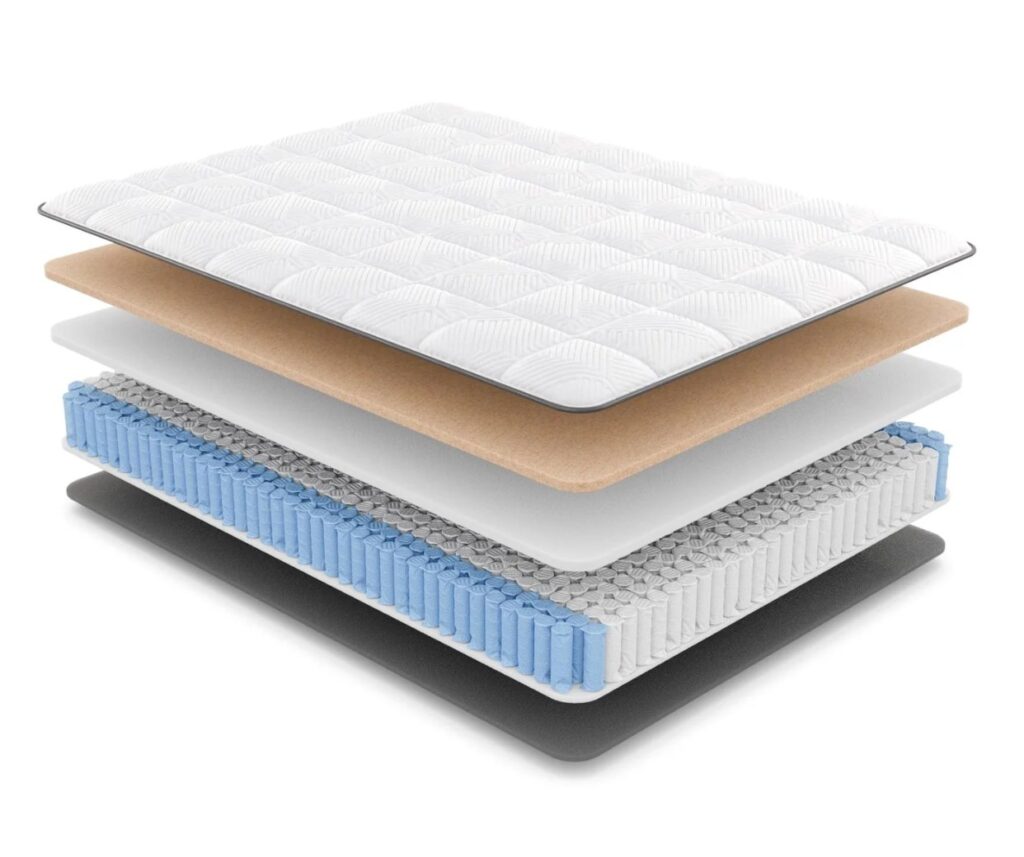
Queen size $899, 120 night trial period, and 20 year warranty. For the money, the pocket coils feel like a resort quality mattress.
Note: this company has been around for awhile, and builds everything in California.
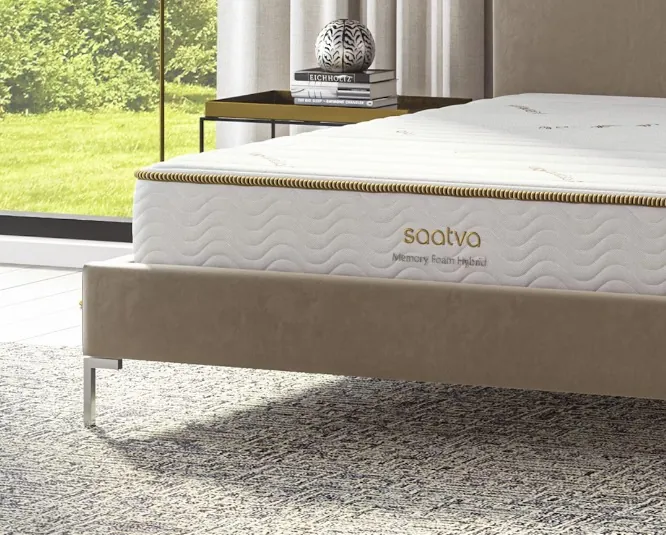
Saatva Memory Foam Hybrid Mattress
Unlike typical bed in a box options, Saatva has a different approach. Their mattresses are delivered unrolled, uncompressed, and installed in your home at no extra charge.
I found that it was highly effective at pain and pressure relief by combining a quilted pillow top, a supportive gel memory foam layer, and a pocketed coil core.
Offers a livelier but not bouncy feel, good for couples, bigger bodies, and with plenty of edge support. $1,495 in queen, $1,895 in king.
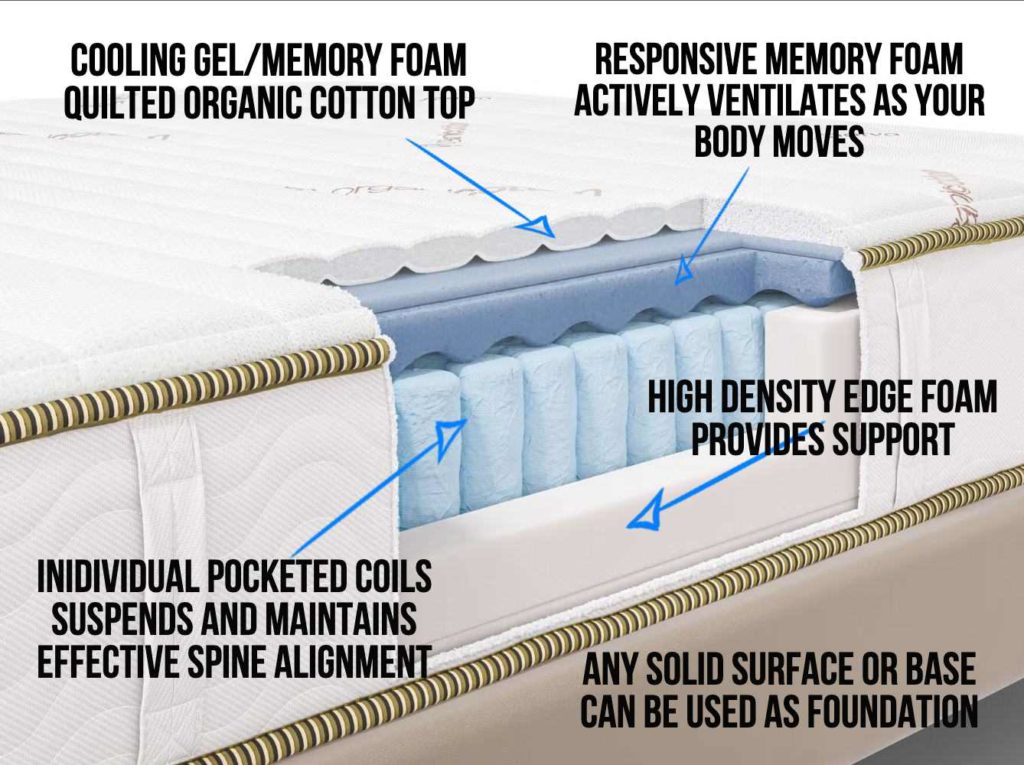
Very simple design less likely to fail or compress, the company includes a lifetime warranty, 365 day trial period, and complimentary removal of your old clunker mattress.
It offers a medium feel, but without that feeling that you have to “dig your way out”. You can read my reviews of other Saatva models here.
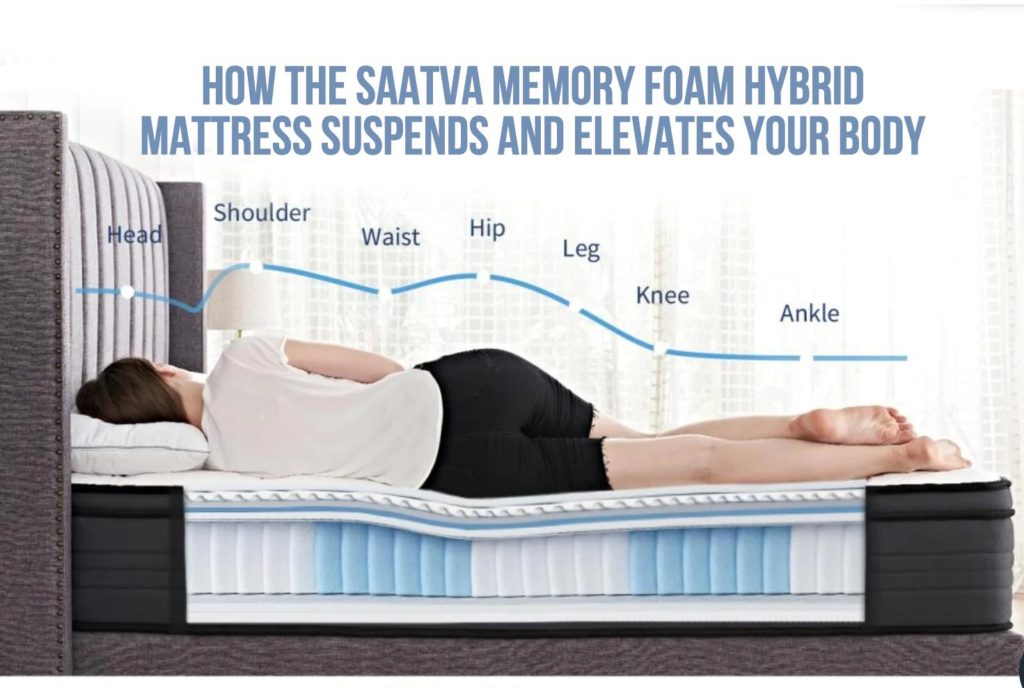
THE DREAMCLOUD PREMIER HYBRID MATTRESS: $1199 IN QUEEN
The DreamCloud Premier Hybrid Mattress is a 14” hybrid mattress with individually pocketed coils, a quilted, silky cashmere top and is a firmer option for people with back issues requiring better back support and spine alignment.
Why I recommend it: It’s a lot less expensive than comparable big box pillow top innersprings, which often don’t include a quilted and comfortable built in top section , making them feel mushier and not as supportive.
It’s slightly softer than most hybrid mattress options, and I loved the way it supported my lower back, neck, and shoulders. It’s very similar in feel to nicer resort mattresses that have billowy tops and a bit of immersion, with no having to dig your way out.
Dreamcloud offers a respectable 365 day no questions asked trial, and a LIFETIME warranty.
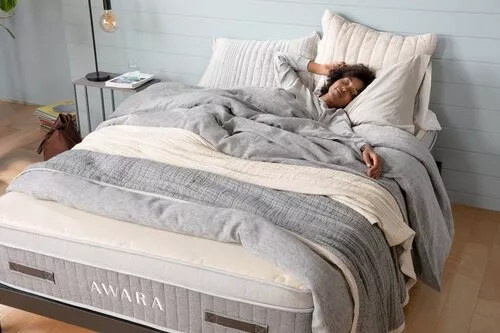
THE AWARA ORGANIC LATEX HYBRID MATTRESS: $1099 IN QUEEN
This outstanding natural latex hybrid bed is stuffed with clean, chemical free ingredients and owners love them. I like the way it’s designed-a breathable organic quilted top fabric, and just below, a layer 2” of 100% pure botanical Dunlop latex.
Another option, well worth the upgrade: Opt for the Premier model and get the thickest layer of pure latex (4” of pure botanical Dunlop latex) in any latex hybrid mattress I’ve reviewed.
I’ve not seen any other brand that offers this at the top of the mattress. It does run $400 more, but you’ll get the best pressure relief and lower back support ever.

Plus they give you a full YEAR to try the mattress out, and back it with a lifetime warranty, too.
Hybrid with 2″ pure latex is just $1099 in queen, $1499 for Premier with 4″ pure latex layer (natural latex mattresses can cost twice this much, usually mixed with a lot of cheaper polyurethane foam). By the way, some bullet points:
- Natural latex resists dust mites, is hypoallergenic, repels mold and mildew
- Contains zero formaldehyde, heavy metals, PBDE’s, or off gassing from VOC fumes.
For a latex/pocketed coil hybrid mattress option, owners rate it highly-likely because of thicker latex material. No other brand gives you a thicker, more sumptuous and supportive layer of pure, botanically derived latex.
The Avocado Eco-Organic Mattress:$1299 In Queen
Looking for a chemical free mattress? Avocado’s value priced mattress is just $1299 in queen. It includes a layer of natural organic latex layer above individually pocketed coils, and has a plush latex topper option available for a modest up-charge.
Up to 988 pocketed coils, no off-gassing, chemicals, VOC fumes, formaldehyde. The outer covering is organic cotton, and the top section is quilted with organic wool.
I found the Avocado Eco-Organic Mattress to be comfortable, and great for hips and shoulders when on my side. For me, I rate it pretty high for a combination foam and coil mattress- and sleeping on a clean and green sleep surface is an added bonus. A solid 4.9 out of 5 star rating.
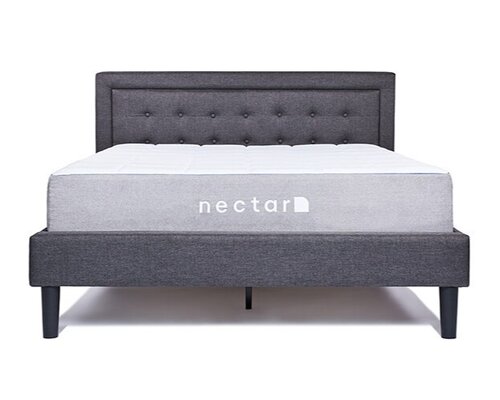
NECTAR MATTRESS: $699 IN QUEEN
The Nectar Mattress is a popular all foam mattress that features a cooling fabric, pressure easing memory and gel foam, and is described as “refreshing” in feel.
It’s somewhat different than comparable brands since it offers a full 5″ of comfort and pressure relieving elements, along with a 6″ layer of high density foam underneath. Great for side sleepers, even couples.
Want to learn more about all of their mattresses? My Nectar Mattress Review Page explains why this popular brand remains as one of the most consistent players on the web, even given the nod by Architectural Digest.
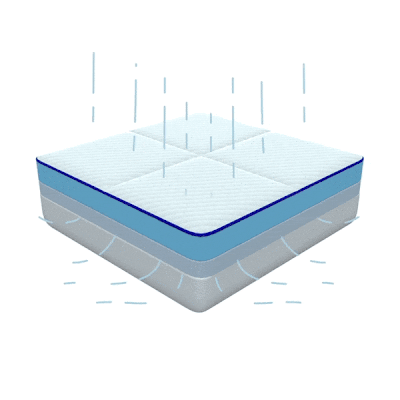
No odor, no VOC’s, Certi-PurUS clean foams. 365 Day Trial, Forever Warranty. For the money, I found it to be supportive, not too soft or firm, and is a great first time mattress or a guest room option
Nectar is a hugely popular brand that I’ve watched from the beginning. Reasonable priced, made with certified greener, cleaner components and higher quality premium memory foam.
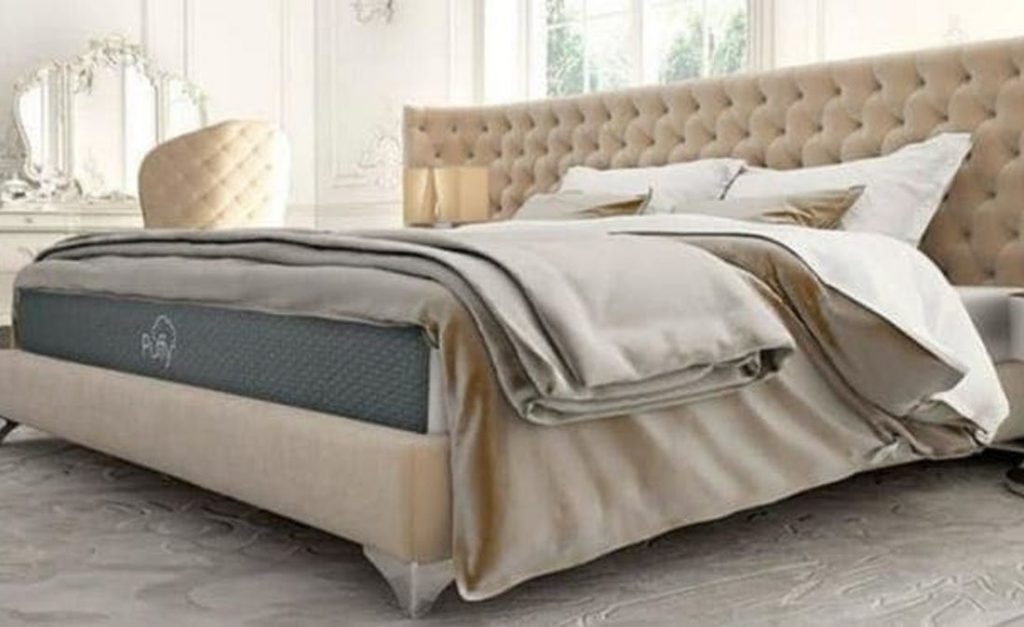
THE PUFFY ORIGINAL MATTRESS: $1049 IN QUEEN
I’ve recommended it for years. Certi-Pur rated non-toxic foams, really good pressure relief for side and back sleepers, innovative design keeps you on top with no sink or digging your way out.
Puffy uses their own recipe of gel/memory foam which is very effective at cooling called “CloudFoam”. The mattress is also quite efficient at distributing weight away from the body to reduce pain.
I studied third party Google reviews that show it as having a 4.9 Rating out of 5, from a total of 6,572 Online Reviews. Definitely worthy.
Out of all of the memory foam/gel foam combination mattresses I’ve reviewed, The Puffy Original has the liveliest feel, not a dead memory foam feel. It’s easy to turn on and is great for couples, too (though not recommended for combined weight over 475lbs.)
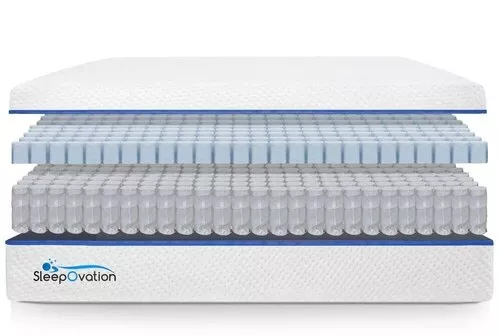
SLEEPOVATION MATTRESS: CANCELS MOTION TRANSFER: $1754 IN QUEEN
The SleepOvation Mattress design functions as an individual suspension system supporting each bone (33) in the human spinal column separately. It cradles the body’s curves while providing enough firmness for the back’s muscular and bony structures.
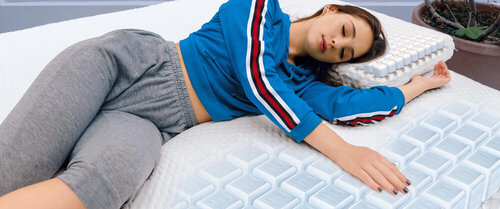
Over 700 small blocks of foam suspended underneath your body isolate motion and provide pinpoint fill in void areas needing lift and support.
I found that this mattress literally shuts down motion transfer. If you have a restless partner- this mattress will really help with that.
The SleepOvation Mattress therapeutically suspends your spine to minimize pressure and promote painless sleep and restorative rest- the stuff you need at night.
It also gives you a buoyant feel, rather than bottoming into the pocketed coil suspension below, which also makes turning pretty effortless.
Rather than using metal springs, this mattress uses foam blocks of differing firmnesses to support and cradle your body. More of a subtle, less bouncy feel, excellent motion dampening.
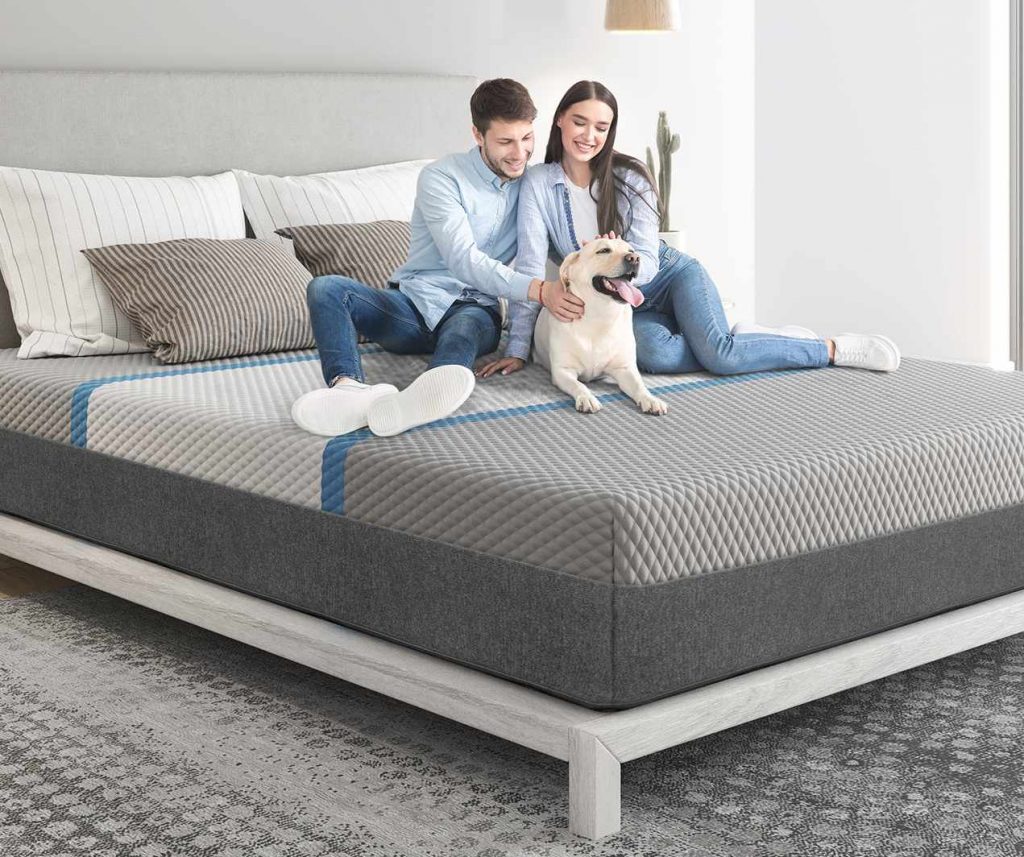
HYPHEN COOLING COPPER FOAM MATTRESS
If you are a hot sleeper and if you’re tossing and turning keeps your partner awake, I’d take a look at this option. Priced at $895 in queen, it’s equipped with copper infused materials as well as orthopedic foam layers.
It’s a bit bouncier than most options in its class, is made using hypo-allergenic foams and water based adhesives (without formaldehyde), and we noticed its low motion transfer.
Built with a specialized layer of memory foam that is infused with elemental copper which is 20,000 times more conductive than conventional polyurethane foam it draws heat rapidly from the body.
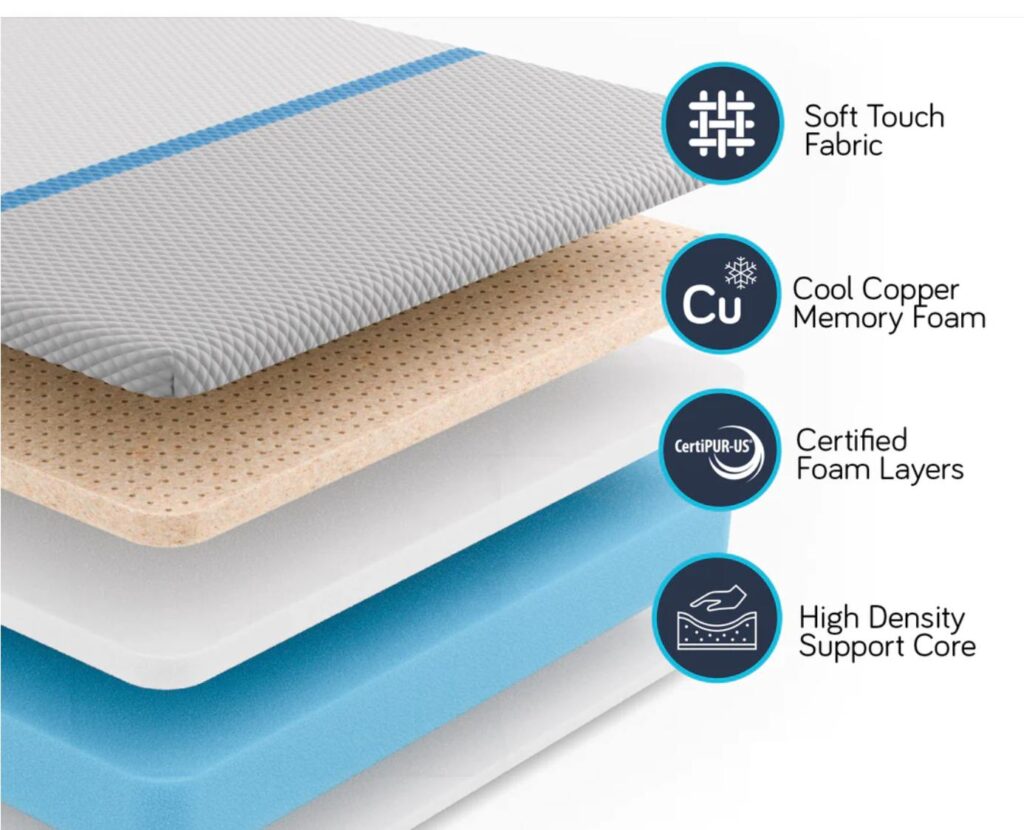
For the money, it offers a few more bullet points I think, and is outfitted with a 120 night trial, a 20 year warranty and is made in the USA.

